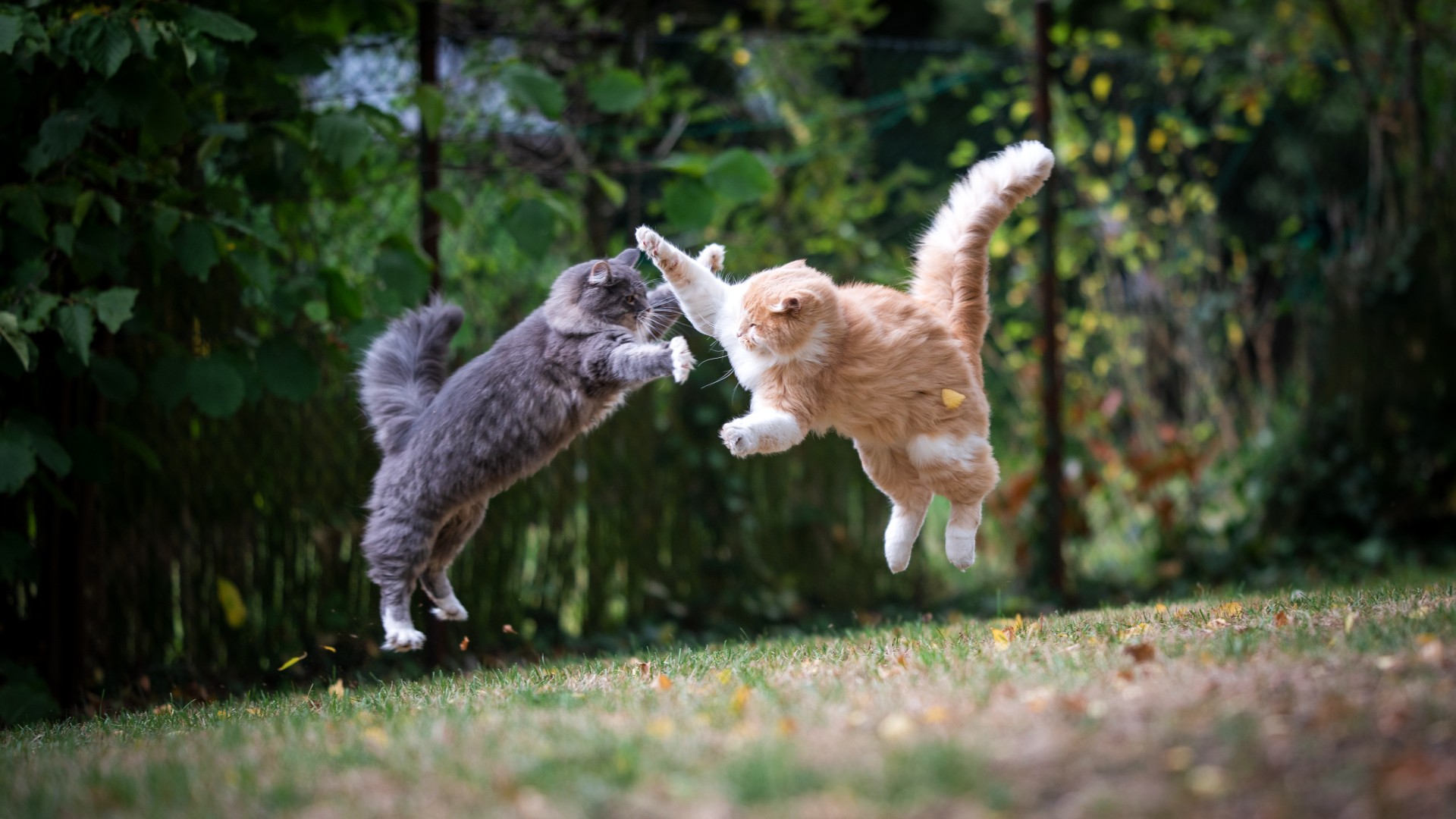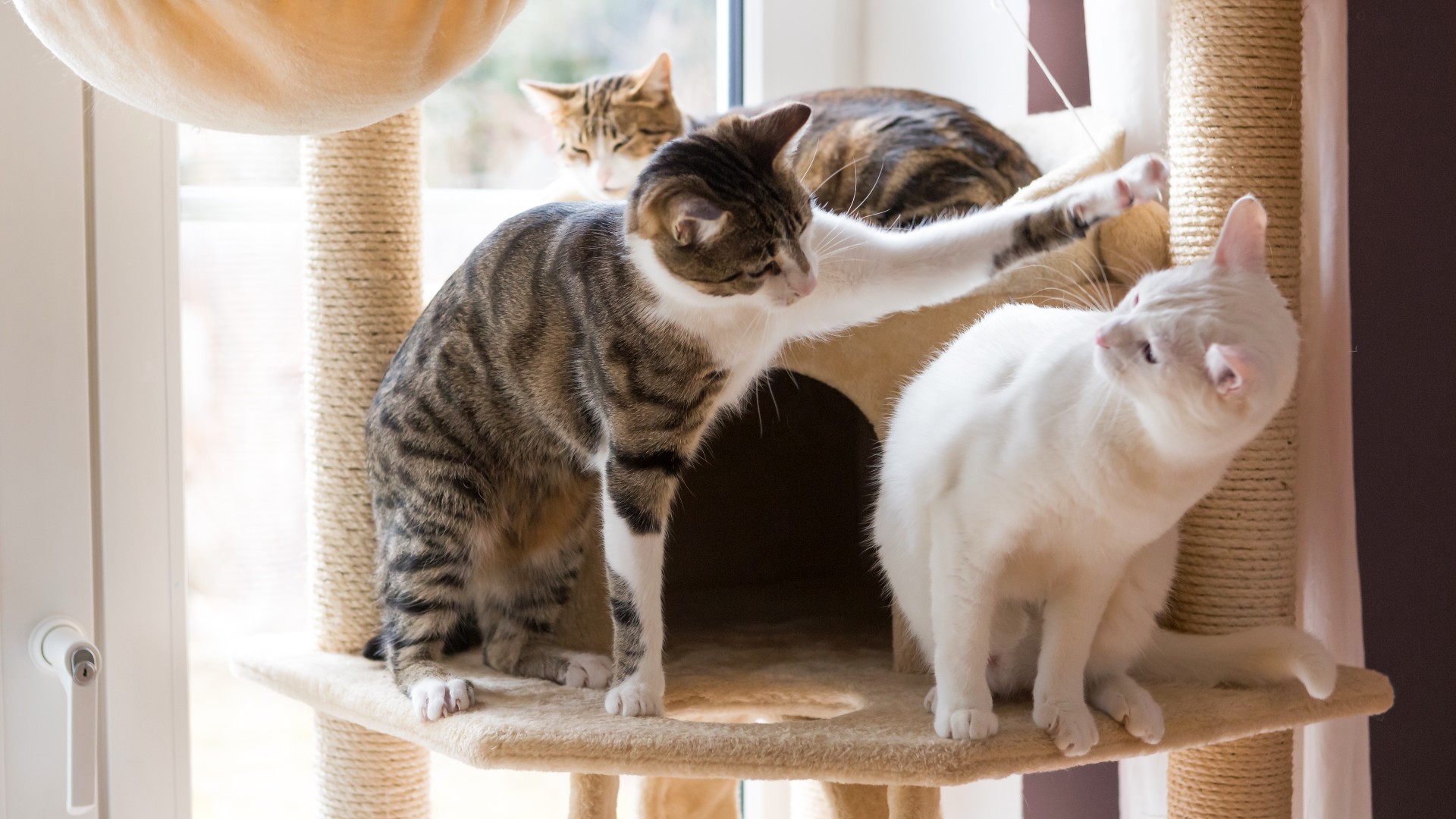How to get cats to get along
Desperate to figure out how to get cats to get along? We have everything you need to know right here!

Learning how to get cats to get along is likely high on your list of priorities right now if you’ve just welcomed another feline fur baby into your family. While some kitties will become immediate best friends, for others, it’s the opposite of love at first sight.
And it’s not just a new cat coming into your home and struggling to get along with your existing kitty that can cause problems, often cats that have lived together for years can suddenly go from friends to enemies leaving you scratching your head wondering where it all went wrong.
It can be really distressing as a pet parent seeing your beloved fur children at each other’s throats, but believe it or not, fighting felines is actually a fairly common cat behavior problem that’s usually solvable once you’ve identified the root cause of the conflict.
In this piece, we explore some of the reasons that often drive conflict between cats and prevent them from getting along, as well as provide you with a range of practical tips and tricks that can help bridge the gap and have peace and harmony restored to your home in no time at all.
- Anxiety in cats: Causes and how to help a stressed feline
- Food aggression in cats: A vet's guide to signs and treatment
- Are my cats playing or fighting? How to tell the difference
Reasons why cats don’t get along
As a feline pet parent, you’ve probably already figured out that cats are complicated creatures who are certainly not backward in coming forward when they’re displeased about something that’s going on in their environment.
Before you can solve the problem of your cat’s disdain for one another, it’s important to understand some of the reasons that might be causing them to not get along. Once you can identify the root cause of the conflict, you’ll be in a much better position to make changes.
1. Status seeking
Whether it’s human beings battling it out in the boardroom for their place in the corporate hierarchy or antelope locking horns on the open grasslands of Africa, it appears the tussle for power and status is alive and well across the entire animal kingdom and our feline friends are no exception.
If you’ve just introduced your furry friend, there’s a good chance that auditions for the role of ‘alpha cat’ will be taking place on the stage that is your living room over the coming months as each feline seeks to assert their dominance. It’s particularly common amongst male cats, who tend to be more territorial.
2. Protecting their turf
Speaking of cats being territorial, alongside seeking status, protecting their territory is another common reason cats might not get along. You’ll tend to notice this most around items such as their food bowl, litter box, favorite sleep spot, and their toys.
3. Illness
Just like we humans, cats can become cranky when they’re feeling unwell and will often be far less tolerant and patient than they would normally be. If your cats normally get along and you suddenly notice that one is instigating fights or acting out, ill health could be the reason.
4. Stress
Cats like predictability and so any changes in their environment, no matter how minor they may seem, can trigger a stress response that can lead them to pick fights with other cats in the home. Things like moving their food bowl or litter box, having a new person in the home, or being out of the house more frequently than you normally would be can all leave your feline furkid feeling out of sorts.
5. Personality clashes
Given that we humans don’t always get along, it shouldn’t come as a surprise that cats can also take a dislike to each other thanks to different personalities and temperaments as well as where each kitty is in their life stage. Sedentary older cats in search of a quiet life, for example, may not gel with playful kittens, while timid kitties may feel scared of their bolder or more aggressive peers.
6. One cat smells different
Cats identify each other by sight, smell and voice, so if one of your cats suddenly smells different, this will act as a signal to the other one who will start seeing their former friend as an intruder. This is really common if you’ve just taken one cat to the vet or groomer, where some of the different smells from that environment may have rubbed off onto them.
7. Resources
One of the biggest reasons that cats fight is that one kitty feels they’re getting an unfair deal when it comes to an even distribution of resources. Common resource-based conflicts include:
- Access to food and water
- Competition over pet parent attention
- Stealing toys
- Trying to sleep in the same spot
So, basically, anything that you’d expect to see children fighting over is pretty much the same as what our feline friends will fight over!
Tips to help cats get along

While it can be upsetting to watch your cats squabbling for whatever reason, it’s completely possible for former feline friends or new furry family members to live together conflict-free. Here are our favorite tips to help bring a sense of peace and harmony to your home:
1. Make a proper introduction
If you’ve just welcomed a new feline furkid into your family, it’s really important that you take the time to introduce this latest addition to your current fur baby. There are four steps that are worthwhile following to help make the introduction go as smoothly as possible:
Step 1: Isolate your new cat in a room by themselves that has everything they need - litter box, food, toys, bed etc. Each mealtime, feed your cats on either side of the same door.
Step 2: The next thing you want to do is to get the cats used to each other's scent. Swap out the blankets in their beds so that they’re each sleeping on the other cat's blanket. Prop the door separating your two fur babies open just enough so that they can see each other but not enough that they can pass through it.
Step 3: Start bringing the two cats together in the same room. You can begin by investing in one of the best cat carriers and popping one of the cats inside while you sit beside the carrier and let the other cat sniff around. Repeat the process so that both cats have time in the carrier and both have time to be introduced to one another in a non-threatening way.
Step 4: Allow your old cat to enter the isolation room with your new cat for two minutes, but ensure you stay in the room with them to see how they engage with one another and prevent fights from breaking out. If things go well, slowly increase by five minutes at a time until the pair are able to be left alone without any issues.
By doing a nice, slow introduction over several days, you greatly increase the chances that both cats will feel at ease around each other and minimize the risk of them getting off on the wrong paw.
2. Spay or neuter your cats
Spaying or neutering your cats can decrease the chances of regular conflict. Male cats, in particular, are prone to aggressive behavior, but you’ll also see this kind of thing occurring with female cats who are nursing - something that’s referred to as maternal aggression.
3. Eliminate the need to compete
Competition over resources is a common cause of conflict in cats, so eliminating this where possible will go a long way to helping your cats get along. Firstly, make sure that you invest in one cat food bowl per cat and set up separate eating areas for each.
Secondly, when it comes to the best cat litter boxes, it can be tempting just to have one that both your cats share, but our feline friends can be really fussy about their bathroom habits and often don’t like doing their business where another cat does, so getting one for each cat will prevent any issues.
Another potential problem area can be cat scratching posts and cat trees, as if you only have one, fights can break out if both are wanting to use the post at the same time or if they both like the same perch on the cat tree. Buying two of each ensures that your cats have plenty of options.
4. Spend equal time with each cat
We highly recommend that you make sure you’re devoting equal amounts of time to each cat, as this will stop them from feeling like they’re missing out or that one is getting more attention than the other. Try picking up a few of the best cat toys and spending 15-20 minutes per day with each cat engaged in some quality bonding time.
5. Give them their own territory
It can be well worth investing in one of the best cat beds for each of your feline friends and giving them their own designated sleep spot in separate areas of the house that they can retreat to when they’re feeling the need to rest and recharge. Having plenty of individual space will help stop territorial fighting, which often occurs when cats are living together in a confined space.
6. Reward good behavior
One of the most important things you can do when it comes to helping your cats to get along is to reward them whenever you see them interacting positively with one another. If your feline friends learn that whenever they cohabit calmly and harmoniously they get rewarded with a few of the best cat treats, they’ll soon learn that it’s much more beneficial all round to have peace instead of war!
7. Speak with your vet
Sometimes, the change in relationship between your cats can come on suddenly, with one cat appearing to become grumpy or aggressive out of the blue. If you find this to be the case, make an appointment with your vet who will be able to investigate and rule out any underlying medical issues that could be causing this change in behavior.
PetsRadar Newsletter
Get the best advice, tips and top tech for your beloved Pets

Kathryn is a freelance writer who has been a member of the PetsRadar family since it launched in 2020. Highly experienced in her field, she's driven by a desire to provide pet parents with accurate, timely, and informative content that enables them to provide their fur friends with everything they need to thrive. Kathryn works closely with vets and trainers to ensure all articles offer the most up-to-date information across a range of pet-related fields, from insights into health and behavior issues to tips on products and training. When she’s not busy crafting the perfect sentence for her features, buying guides and news pieces, she can be found hanging out with her family (which includes one super sassy cat), drinking copious amounts of Jasmine tea and reading all the books.
